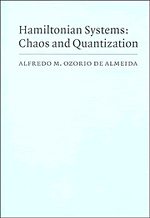4 - Normal forms
Published online by Cambridge University Press: 05 July 2011
Summary
Having established the ubiquity of periodic orbits in dynamical systems, we now return to the study of the motion near a given periodic orbit, fixed point or point of equilibrium. The Hartman–Grobman theorem of section 2.2 guarantees the existence of a continuous coordinate transformation that linearizes the vector field near a hyperbolic fixed point, but no indication is given as to how to construct this transformation. The method of normal forms, invented by Poincaré, consists of eliminating nonlinear terms of the vector field by successive polynomial transformations. If this process can be carried out to all orders, the resulting compound transformation can be shown to be convergent in some cases, and an analytic reduction of the nonlinear vector field to a linear one is thus achieved. This transformation can be approximated to arbitrary accuracy.
One of the cases in which this process can never be carried out is that of Hamiltonian systems. The Hamiltonian cannot generally be made quadratic by a canonical transformation, though Birkhoff showed that it can be simplified into a form that shares some of the important features of quadratic Hamiltonians. For hyperbolic points this transformation is analytic in a narrow neighbourhood of the separatrices, allowing us to calculate precisely some homoclinic orbits and the periodic orbit families that accumulate on them.
- Type
- Chapter
- Information
- Hamiltonian SystemsChaos and Quantization, pp. 74 - 99Publisher: Cambridge University PressPrint publication year: 1989

